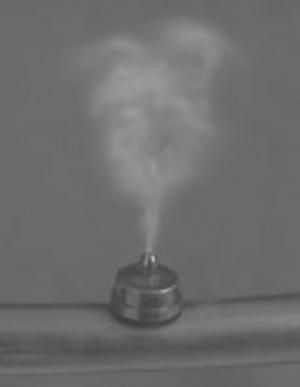"Injected" CO2 Gas Doubles Crop Yields
 ✖  |
Carbon dioxide gas - the same stuff that gives a bottle of Coke its fizz - is being used in California to boost yields on strawberries, tomatoes, peppers, and other high value crops. The method works so well it might not be long before it's tried on lower value row crops.
The idea of "flooding" crops with clouds of CO2 gas came from AG Gas, Hudson, Wis. The company is working with the Center for Irrigation Technology at Fresno State University. Strawberry yields have been increased by 30 percent, and tomatoes have more than doubled with a 120 percent increase in marketable output by weight.
The carbon dioxide is released in the crops by above-ground drip irrigation lines and absorbed by the leaves and foliage of the growing plants. It is applied during periods when irrigation water is turned off.
The process, in its sixth year of development, is called Carbogation. AG Gas is developing the methods and hardware needed to make the process possible, including storage tanks, manifolds, metering, pressure regulators, programmable logic controller, computer, and instruments in the field to monitor the carbon dioxide needs of plants.
Carbon dioxide is generated as a byproduct by several industrial applications including oil refining, cement plants, and coal-fired power plants. The California researchers get their carbon dioxide from nearby oil refineries. Stewart Erickson, chief executive officer of AG Gas, says the cost of carbon dioxide is the driving factor, especially for lower commodity crops such as corn and soybeans.
Midwest ethanol plants could become a future source of the product. "The closer the agricultural application is to the CO2 source, the more economical it is to use. Ethanol plants are big producers of carbon dioxide, and they produce a lower grade of carbon dioxide, which reduces the cost," he says.
The company recently set up a commercial farm-pilot project with a California strawberry grower, and is trying to sign up growers of tomatoes and peppers. "California is only a starting point for the technology. We believe that in coming years this technology will quickly migrate into other regions and even overseas," says Erickson. "We haven't tried the process in corn or soybeans, but next summer we plan to expand research into other types of crops. We've looked at center pivot irrigation systems but we don't think carbon dioxide will work with them. The gas has to be uniformly distributed throughout the entire field during daylight hours, when the crop is at a high rate of photosynthesis. It doesn't do any good to apply it at night."
Contact: FARM SHOW Followup, AG Gas, No. 1 Birkmose Park, Hudson, Wis. 54016 (ph 715 381-5200; fax 715 425-5400 or 7940 N. Maple Ave., Suite 108, Fresno, Calif. 93720 (ph 559 323-7706; fax 559 323-7771).

Click here to download page story appeared in.
Click here to read entire issue
"Injected" CO2 Gas Doubles Crop Yields CROPS Miscellaneous 28-6-29 Carbon dioxide gas - the same stuff that gives a bottle of Coke its fizz - is being used in California to boost yields on strawberries, tomatoes, peppers, and other high value crops. The method works so well it might not be long before it's tried on lower value row crops.
The idea of "flooding" crops with clouds of CO2 gas came from AG Gas, Hudson, Wis. The company is working with the Center for Irrigation Technology at Fresno State University. Strawberry yields have been increased by 30 percent, and tomatoes have more than doubled with a 120 percent increase in marketable output by weight.
The carbon dioxide is released in the crops by above-ground drip irrigation lines and absorbed by the leaves and foliage of the growing plants. It is applied during periods when irrigation water is turned off.
The process, in its sixth year of development, is called Carbogation. AG Gas is developing the methods and hardware needed to make the process possible, including storage tanks, manifolds, metering, pressure regulators, programmable logic controller, computer, and instruments in the field to monitor the carbon dioxide needs of plants.
Carbon dioxide is generated as a byproduct by several industrial applications including oil refining, cement plants, and coal-fired power plants. The California researchers get their carbon dioxide from nearby oil refineries. Stewart Erickson, chief executive officer of AG Gas, says the cost of carbon dioxide is the driving factor, especially for lower commodity crops such as corn and soybeans.
Midwest ethanol plants could become a future source of the product. "The closer the agricultural application is to the CO2 source, the more economical it is to use. Ethanol plants are big producers of carbon dioxide, and they produce a lower grade of carbon dioxide, which reduces the cost," he says.
The company recently set up a commercial farm-pilot project with a California strawberry grower, and is trying to sign up growers of tomatoes and peppers. "California is only a starting point for the technology. We believe that in coming years this technology will quickly migrate into other regions and even overseas," says Erickson. "We haven't tried the process in corn or soybeans, but next summer we plan to expand research into other types of crops. We've looked at center pivot irrigation systems but we don't think carbon dioxide will work with them. The gas has to be uniformly distributed throughout the entire field during daylight hours, when the crop is at a high rate of photosynthesis. It doesn't do any good to apply it at night."
Contact: FARM SHOW Followup, AG Gas, No. 1 Birkmose Park, Hudson, Wis. 54016 (ph 715 381-5200; fax 715 425-5400 or 7940 N. Maple Ave., Suite 108, Fresno, Calif. 93720 (ph 559 323-7706; fax 559 323-7771).
To read the rest of this story, download this issue below or click
here to register with your account number.







